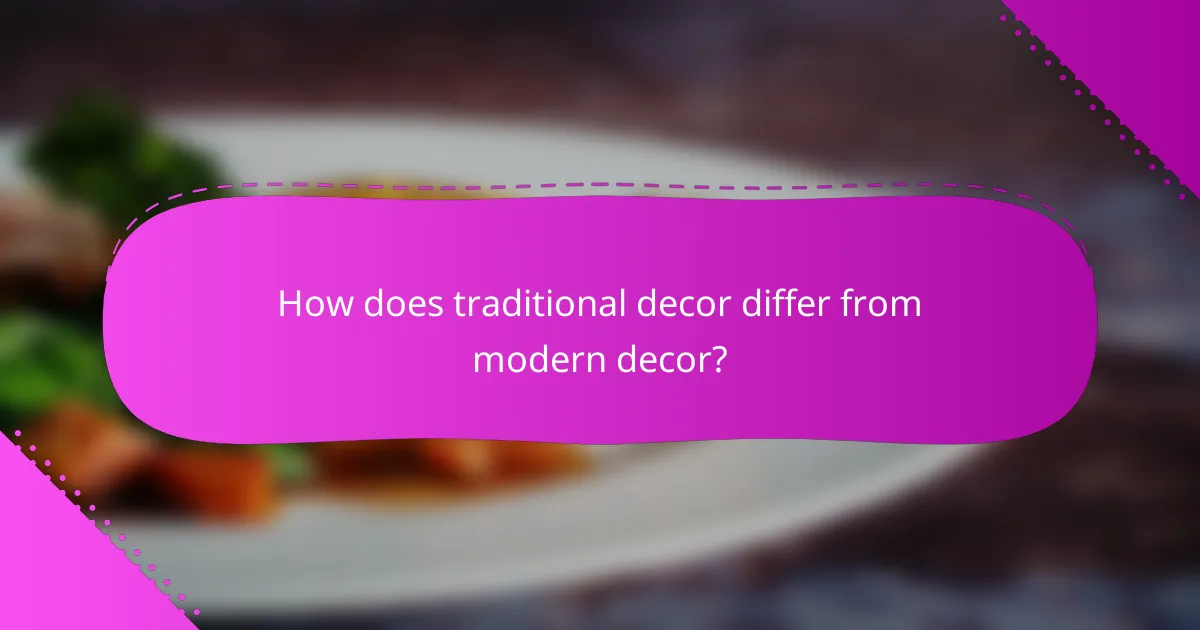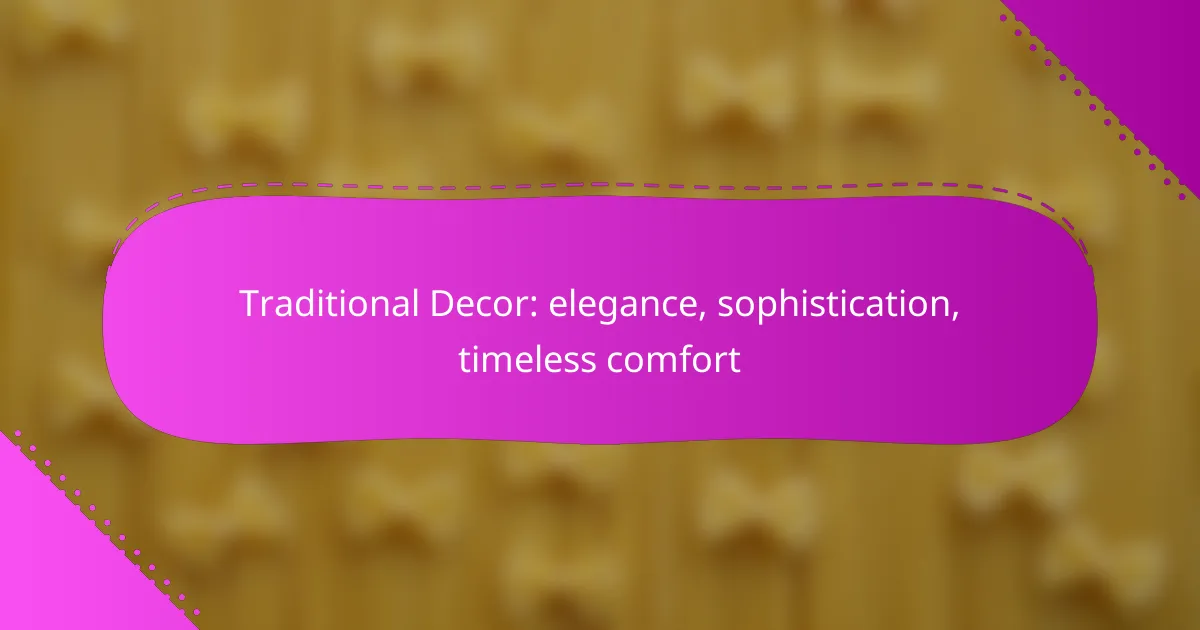Traditional decor embodies elegance and sophistication, offering a timeless comfort that enhances any living space. By incorporating classic elements such as rich fabrics, symmetrical designs, and carefully selected artwork, you can create a harmonious atmosphere that reflects a deep appreciation for craftsmanship and history. This style contrasts with modern minimalism, inviting warmth and character into your home.

How to incorporate traditional decor in your home?
Incorporating traditional decor in your home involves blending classic elements that evoke elegance and timeless comfort. Focus on selecting furniture, colors, accessories, textiles, and artwork that reflect traditional styles to create a cohesive and sophisticated atmosphere.
Use classic furniture styles
Selecting classic furniture styles is essential for achieving a traditional decor look. Opt for pieces like tufted sofas, wingback chairs, and wooden dining tables with intricate carvings. These items not only provide comfort but also serve as focal points in your space.
Consider sourcing furniture from reputable antique shops or high-quality reproductions to ensure durability and authenticity. Mixing different styles, such as Victorian and Colonial, can add depth while maintaining a cohesive traditional aesthetic.
Choose rich color palettes
A rich color palette is a hallmark of traditional decor. Deep hues such as burgundy, navy, forest green, and gold can create a warm and inviting environment. Use these colors on walls, upholstery, and accents to enhance the overall elegance of your home.
When selecting colors, consider the natural light in your space. Darker shades can make a room feel cozy, while lighter tones can brighten it up. Aim for a balanced mix of colors to avoid overwhelming the senses.
Add vintage accessories
Vintage accessories are vital for adding character to traditional decor. Look for items like ornate mirrors, antique clocks, and decorative vases that reflect the craftsmanship of bygone eras. These pieces can serve as conversation starters and enhance the overall charm of your home.
Incorporate a mix of textures and materials, such as brass, crystal, and porcelain, to create visual interest. Be mindful of scale; larger accessories can anchor a room, while smaller items can add subtle details.
Utilize ornate textiles
Ornate textiles play a crucial role in traditional decor, providing warmth and sophistication. Choose fabrics like brocade, damask, and velvet for upholstery, curtains, and throw pillows. These materials not only feel luxurious but also add depth to your color palette.
Layering textiles can enhance comfort and style. Consider using patterned rugs, embroidered tablecloths, and decorative cushions to create a cozy atmosphere. Ensure that the patterns complement each other to maintain a harmonious look.
Incorporate traditional artwork
Traditional artwork is essential for completing the decor theme. Look for classic paintings, landscapes, or portraits that resonate with the traditional style. Framed art can serve as a focal point or accentuate the room’s color scheme.
Consider displaying art in groups to create a gallery wall effect. Use ornate frames that match the furniture style to unify the decor. This approach not only enhances visual interest but also reflects your personal taste and appreciation for traditional aesthetics.

What are the key elements of traditional decor?
Traditional decor is characterized by its emphasis on elegance, sophistication, and timeless comfort. Key elements include symmetry, classic furniture, rich fabrics, and elegant color schemes that together create a harmonious and inviting atmosphere.
Symmetry in design
Symmetry is a fundamental aspect of traditional decor, creating balance and order in a space. This can be achieved through the arrangement of furniture, artwork, and architectural features, ensuring that elements mirror each other on either side of a central axis.
For instance, placing matching armchairs on either side of a fireplace or using identical lamps on a console table enhances the sense of symmetry. This balance not only pleases the eye but also contributes to a feeling of stability and comfort in the room.
Classic furniture pieces
Classic furniture pieces are essential in traditional decor, often featuring ornate details and high-quality craftsmanship. Look for items like wingback chairs, tufted sofas, and wooden dining tables with intricate carvings that reflect a timeless style.
Investing in well-made, classic furniture can elevate the overall aesthetic of your space. Consider sourcing pieces from reputable antique shops or high-end retailers that specialize in traditional designs to ensure longevity and authenticity.
Rich fabrics and textures
Rich fabrics and textures play a crucial role in traditional decor, adding depth and warmth to a room. Materials such as velvet, silk, and brocade are commonly used for upholstery, curtains, and cushions, creating a luxurious feel.
Layering different textures can enhance the comfort of the space. For example, combining a plush velvet sofa with silk throw pillows and a wool area rug can create an inviting and sophisticated atmosphere that encourages relaxation.
Elegant color schemes
Elegant color schemes in traditional decor typically feature muted tones and rich hues that evoke a sense of refinement. Colors like deep reds, navy blues, and soft creams are often used to create a cohesive and inviting palette.
When selecting colors, consider using a combination of warm and cool tones to achieve balance. A classic approach is to use darker shades for larger furniture pieces and lighter colors for walls and accents, ensuring a harmonious flow throughout the space.

How does traditional decor differ from modern decor?
Traditional decor is characterized by its emphasis on historical influences, natural materials, and craftsmanship, contrasting sharply with the minimalist and often industrial approach of modern decor. While modern styles prioritize simplicity and functionality, traditional decor embraces ornate details and a sense of warmth, creating a timeless comfort in living spaces.
Focus on historical influences
Traditional decor draws heavily from historical styles, often reflecting the aesthetics of specific eras such as Victorian, Colonial, or Renaissance. This influence can be seen in the use of classic patterns, rich color palettes, and antique furnishings that tell a story and evoke a sense of nostalgia.
When incorporating historical influences, consider the architectural style of your home. For instance, a Victorian-era home may benefit from intricate moldings and period-appropriate wallpaper, while a Colonial-style house might suit simpler, more symmetrical designs.
Use of natural materials
Natural materials are a hallmark of traditional decor, emphasizing wood, stone, and textiles like wool and cotton. These materials not only enhance the aesthetic but also contribute to a warm and inviting atmosphere that modern synthetic materials often lack.
To achieve a traditional look, opt for solid wood furniture, stone countertops, and handcrafted textiles. For example, a mahogany dining table paired with linen tablecloths can create a sophisticated yet comfortable dining experience.
Emphasis on craftsmanship
Craftsmanship is a key element in traditional decor, where the quality of workmanship is paramount. Handcrafted items, whether furniture or decorative pieces, showcase the skill and artistry of artisans, adding character and uniqueness to a space.
When selecting decor, prioritize items that highlight craftsmanship, such as hand-carved wooden furniture or handwoven rugs. This focus not only supports artisans but also ensures that your decor has a personal touch and a story behind it.

What are the benefits of traditional decor?
Traditional decor offers numerous benefits, including a sense of elegance, sophistication, and timeless comfort. This style creates inviting spaces that evoke nostalgia while providing a classic aesthetic that remains relevant across generations.
Creates a warm atmosphere
Traditional decor is known for its ability to create a warm and inviting atmosphere in any space. By incorporating rich colors, soft fabrics, and layered lighting, this style fosters a sense of comfort and relaxation.
Elements such as plush sofas, warm wood tones, and decorative accessories like throw pillows and area rugs contribute to a cozy environment. Consider using warm lighting fixtures, such as chandeliers or table lamps, to enhance this effect.
Timeless aesthetic appeal
The timeless aesthetic of traditional decor ensures that it never goes out of style. Classic design elements, such as ornate moldings, antique furniture, and traditional patterns, create a sophisticated look that appeals to a wide range of tastes.
Incorporating elements like damask fabrics, floral wallpapers, and vintage artwork can elevate the overall design. This enduring appeal makes traditional decor a wise choice for homeowners looking to maintain a stylish yet classic environment.
Enhances property value
Investing in traditional decor can enhance the overall value of a property. Homes that feature classic design elements often attract buyers who appreciate the elegance and comfort associated with this style.
When considering renovations or updates, focus on high-quality materials and timeless finishes, such as hardwood floors and custom cabinetry. These choices not only improve aesthetic appeal but can also lead to higher resale values in the competitive real estate market.

What are popular traditional decor styles in the UK?
Popular traditional decor styles in the UK include Georgian, Victorian, and Edwardian designs, each characterized by distinct architectural features and furnishings. These styles emphasize elegance, sophistication, and timeless comfort, often incorporating rich materials and classic patterns.
Georgian style
Georgian style, prevalent from the early 18th century to the early 19th century, is known for its symmetry and proportion. Key elements include tall windows, decorative cornices, and elegant moldings, often complemented by classic furniture pieces.
When decorating in the Georgian style, consider using a muted color palette with deep greens, blues, and warm neutrals. Incorporate period-appropriate furnishings like wingback chairs and mahogany tables, and add accessories such as porcelain vases and oil paintings to enhance the sophisticated atmosphere.
To avoid common pitfalls, ensure that your decor maintains balance and harmony. Avoid overly modern elements that clash with the traditional aesthetic, and focus on quality materials that reflect the craftsmanship of the period.
